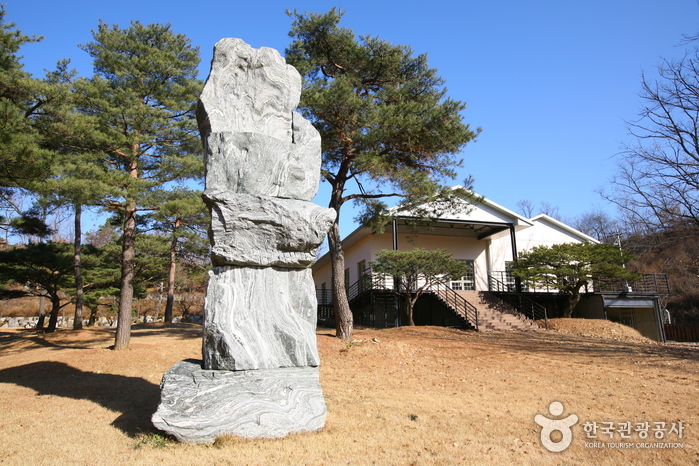Haewoojae Museum (Mr. Toilet House) (해우재)
5.5Km 2024-12-30
463 Jangan-ro, Jangan-gu, Suwon-si, Gyeonggi-do
Haewoojae Museum is the world's only toilet-shaped museum. Its name means "a house to relieve one’s concerns," a term used in temples when referring to the restroom. It includes an exhibition hall, a library, and an experience center. The permanent exhibition on the first floor introduces the history and science of toilets from the 1950s to the present. The second floor hosts special exhibitions. The children's experience center offers the opportunity of learning about the digestive process in the human body.
Gwanggyosan Mountain (광교산)
5.6Km 2024-02-29
58 Sanggwanggyo-dong, Jangan-gu, Suwon-si, Gyeonggi-do
Gwanggyosan Mountain straddles the cities of Suwon and Yongin. Its summit, Shirubong Peak, stands at 852 meters above sea level. The mountain is located in a plain area with no large mountains around it, and the ridges are very gentle and lush with trees in all directions, so many people visit for forest bathing and hiking. Its winter snowscapes are particularly renowned. Notable cultural assets include the tomb and monument of General Kim Joon Ryong, built to commemorate his great victory during the Qing invasion of Joseon, and the tomb of Sim On who served as a civil minister in Joseon dynasty.
Olive Young - Suwon Mangpo Branch [Tax Refund Shop] (올리브영 수원망포)
5.7Km 2024-04-19
127, Yeongtong-ro, Yeongtong-gu, Suwon-si, Gyeonggi-do
-
Lotte Mart - Yeongtong Branch [Tax Refund Shop] (롯데마트 영통점)
5.8Km 2024-04-22
1579, Bongyeong-ro, Yeongtong-gu, Suwon-si, Gyeonggi-do
-
Homeplus - Yeongtong Branch [Tax Refund Shop] (홈플러스 영통)
5.9Km 2024-04-19
1576, Bongyeong-ro, Yeongtong-gu, Suwon-si, Gyeonggi-do
-
Olive Young - Suwon Yeongtong Station Branch [Tax Refund Shop] (올리브영 수원영통역점)
5.9Km 2024-06-27
1F, #103, 1606, Bongyeong-ro, Yeongtong-gu, Suwon-si, Gyeonggi-do
-
Innisfree - Suwon Yeongtong Branch [Tax Refund Shop] (이니스프리 수원영통)
6.0Km 2024-04-19
6, Bandal-ro 7beon-gil, Yeongtong-gu, Suwon-si, Gyeonggi-do
-
Olive Young - Suwon Homaesil Branch [Tax Refund Shop] (올리브영 수원호매실점)
6.5Km 2024-06-27
15, Geumgok-ro 102beon-gil, Gwonseon-gu, Suwon-si, Gyeonggi-do
-
Ieyoung Contemporary Art Museum (이영미술관)
6.7Km 2021-05-28
63, Heungdeok 4-ro, Giheung-gu, Yongin-si, Gyeonggi-do
Ieyoung Contemporary Art Museum opened in June 2001 to showcase artworks that were personally collected by the gallery owners. Upon entering the eco-friendly exhibition space, visitors will be met by works of Korea's famous contemporary artists. In particular, the gallery has the largest collection of works by Park Saeng-gwang, a patriotic painter. In 2004, to mark the 100th anniversary of Park’s birth, the gallery created a foundation with the dual purpose of studying Park and his works and identifying undiscovered interpretation of Korea's tradition.
Kyung Hee University Global Campus Outdoor Theater(경희대학교 국제캠퍼스 노천극장)
6.8Km 2024-10-22
1732, Deogyeong-daero, Giheung-gu, Yongin-si, Gyeonggi-do
'As if it's your last' music video
The background of the music video filled with pink lights symbolizing BLACKPINK is an outdoor theater at Kyung Hee University International Campus. It is a large outdoor theater that can accommodate about 6,500 people. The majestic building and fan-shaped seats make it look like an ancient Athenian temple. It is said to have been built based on the actual Theater of Dionysos in the 6th century BC. There is a lake behind the theater, so it is good to take a walk.

![Olive Young - Suwon Mangpo Branch [Tax Refund Shop] (올리브영 수원망포)](http://tong.visitkorea.or.kr/cms/resource/92/2889492_image2_1.jpg)
![Lotte Mart - Yeongtong Branch [Tax Refund Shop] (롯데마트 영통점)](http://tong.visitkorea.or.kr/cms/resource/55/2887855_image2_1.jpg)
![Homeplus - Yeongtong Branch [Tax Refund Shop] (홈플러스 영통)](http://tong.visitkorea.or.kr/cms/resource/03/2888603_image2_1.jpg)
![Innisfree - Suwon Yeongtong Branch [Tax Refund Shop] (이니스프리 수원영통)](http://tong.visitkorea.or.kr/cms/resource/99/2889699_image2_1.jpg)


 English
English
 한국어
한국어 日本語
日本語 中文(简体)
中文(简体) Deutsch
Deutsch Français
Français Español
Español Русский
Русский